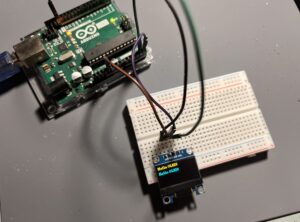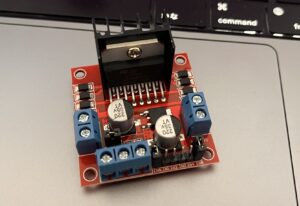
ESP8266 NodeMCU + 128*64 SSD1306 OLED
ESP8266プラットフォームのインストール
1. Arduino を起動し、「Preferences(環境設定)」ウィンドウを開きます
2. Arduino IDE の File > Preferences > Additional Boards Manager URLs に、以下のURLを入力します:
https://arduino.esp8266.com/stable/package_esp8266com_index.json
複数のURLを追加する場合は、カンマ( , )で区切って入力してください。
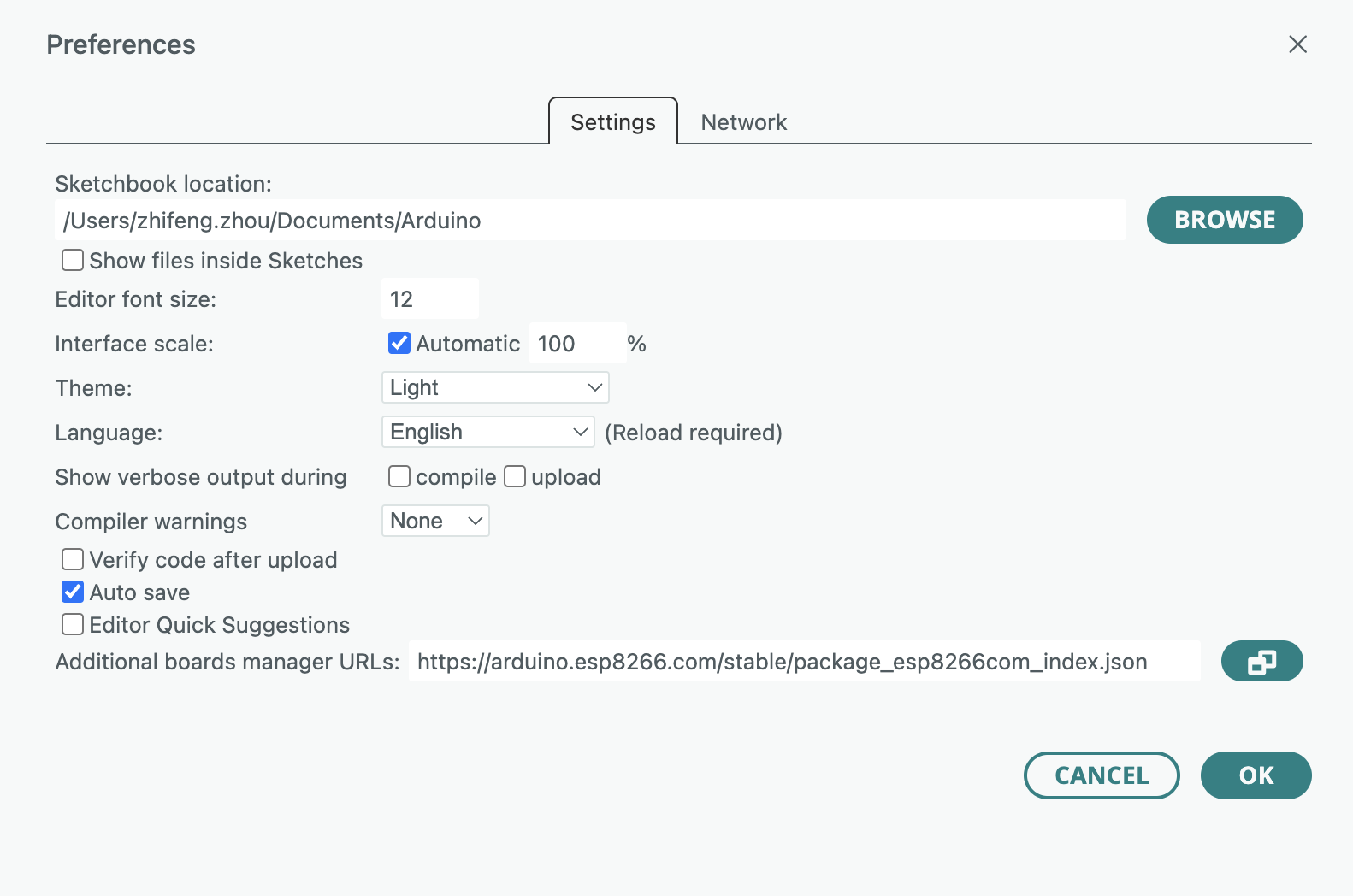
3. 「Tools」 > 「Board: xxxx」 メニューから 「Boards Manager...」 を開き、esp8266 プラットフォームをインストールします。
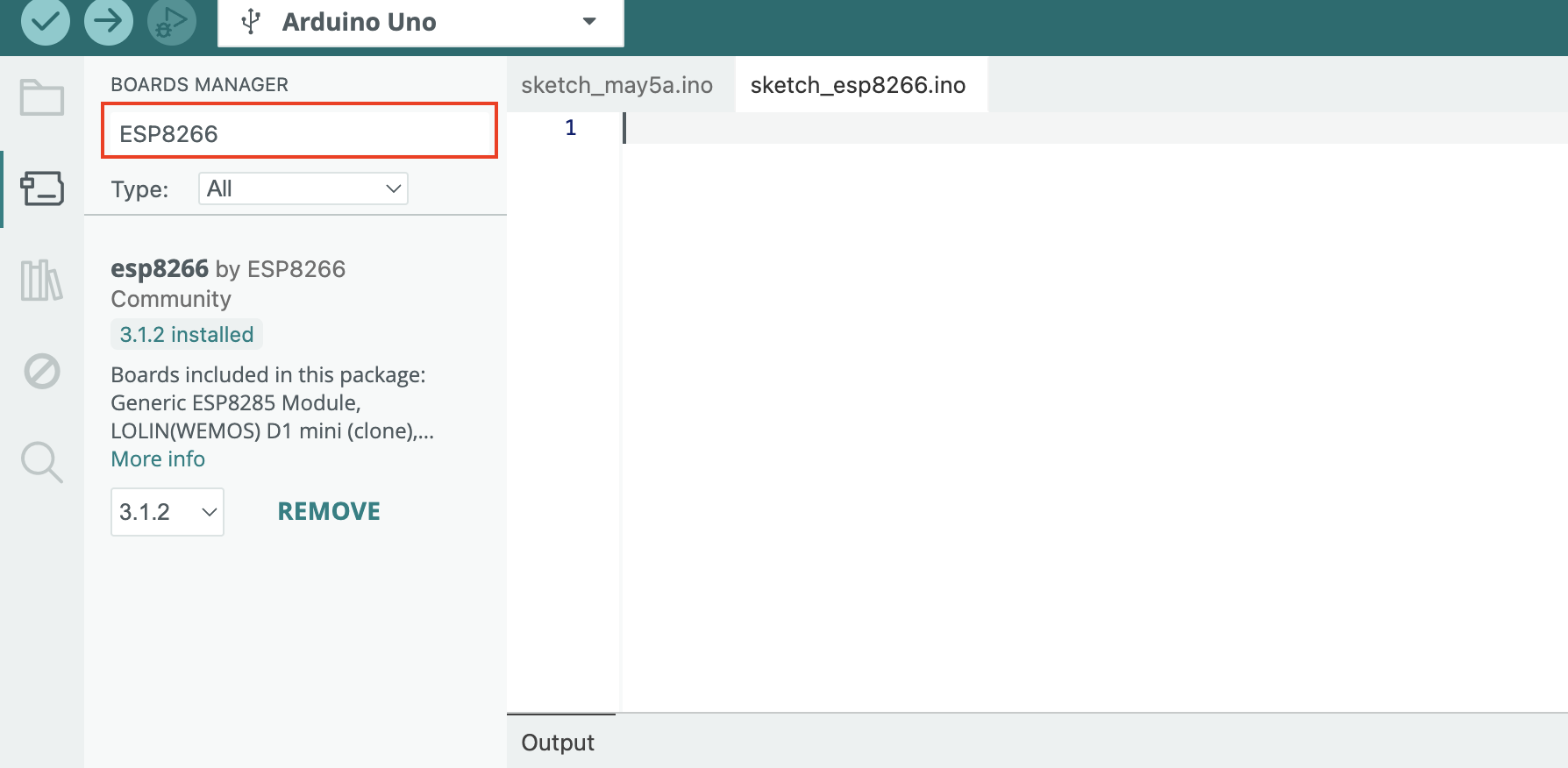
インストール完了後、「Tools」 > 「Board: xxx」 メニューから使用する ESP8266 ボードを選択してください。
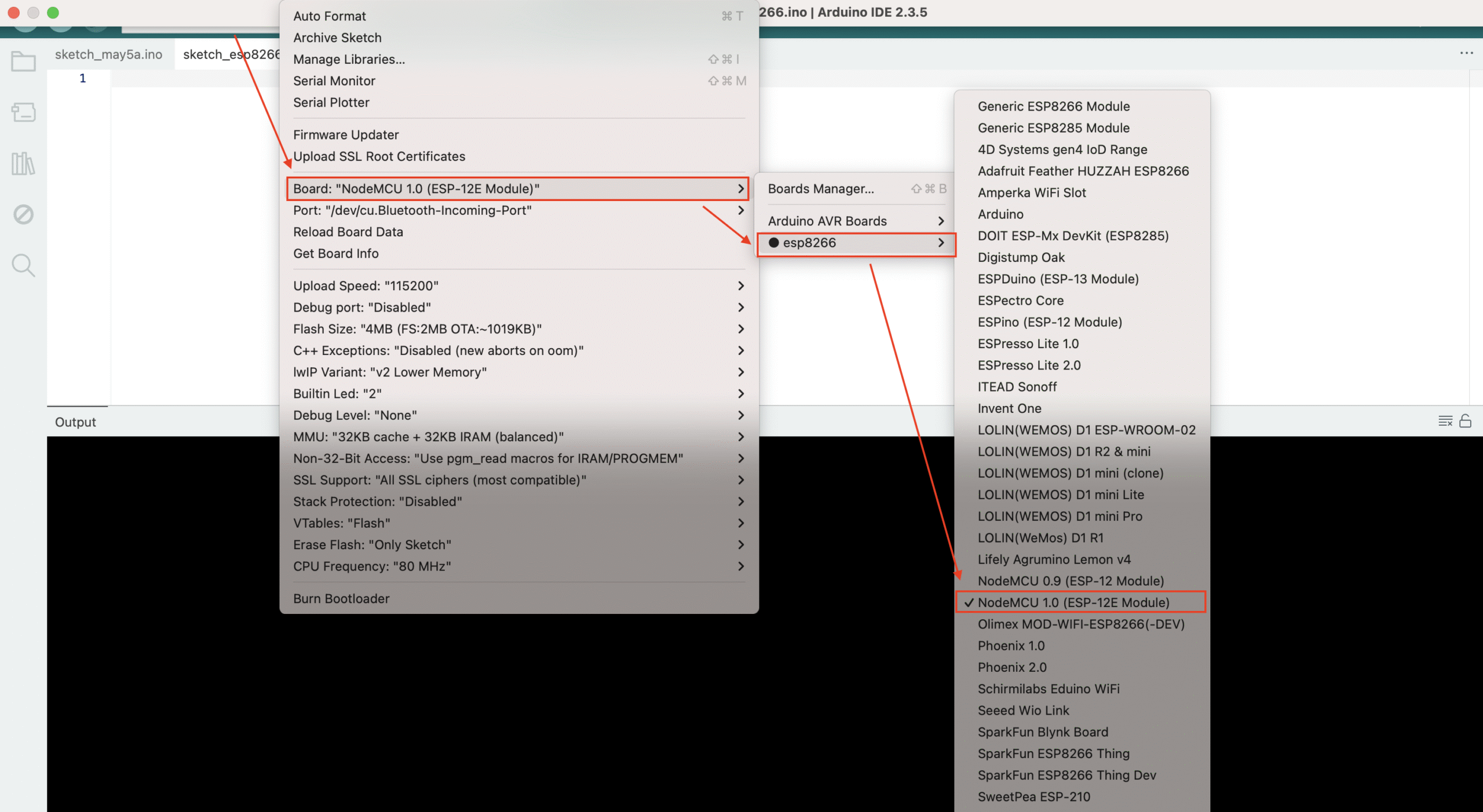
ESP8266とOLEDの接続
| ESP8266 | OLED |
|---|---|
| VCC | 3.3V電源 |
| GND | GND |
| SCL | D1(GPIO5) |
| SDA | D2(GPIO4) |
一部のOLEDモジュールでは、SCLとSDAの代わりに CLK(クロック)や DAT(データ)などのラベルが付いている場合がありますのでご注意ください。
サンプルコード
参考コード:https://github.com/printlndarling
/* 本代码适用于ESP8266 NodeMCU + 128*64 SSD1306 OLED显示屏
*
* 此代码实现了连接WiFi,并自动从ntp服务器同步时间和日期,并且显示在屏幕上,
* 实时刷新,同时设定了115200波特率与PC进行通信,当PC发送"ON"时,
* esp8266便会打开led灯,并在屏幕显示灯已打开,当发送"OFF"时,
* 便会关闭led灯,当发送的其他内容时,esp8266便会将接收的内容打印
* 显示在oled屏幕上。
*
* 4pin IIC引脚,正面看,从左到右依次为GND、VCC、SCL、SDA
* ESP8266 --- OLED
* 3.3V --- VCC
* G (GND) --- GND
* D1(GPIO5)--- SCL
* D2(GPIO4)--- SDA
*
*
* auther: 繁星_逐梦 https://github.com/printdarling/esp8266_clock
*/
#include <ESP8266WiFi.h>
#include <Wire.h>
#include <U8g2lib.h>
#include <TimeLib.h>
#include <time.h>
#include <sys/time.h>
#define SCREEN_WIDTH 128
#define SCREEN_HEIGHT 64
U8G2_SSD1306_128X64_NONAME_F_SW_I2C u8g2(U8G2_R0, D1, D2, U8X8_PIN_NONE);
const char *ssid = "ssid"; //改为您的WiFi名称
const char *password = "password"; //改为您的wifi密码
const char *ntpServerName = "pool.ntp.org";
int hr, mint, sec, dayy, mon, yr;
const int maxCharsPerLine = 16;
void setup()
{
Serial.begin(115200);
pinMode(LED_BUILTIN, OUTPUT);
digitalWrite(LED_BUILTIN, HIGH);//默认关闭led灯
u8g2.begin();
u8g2.enableUTF8Print();
u8g2.setFont(u8g2_font_wqy12_t_gb2312);
u8g2.clearBuffer();
u8g2.setCursor(0, 15);
u8g2.print("开机");
u8g2.setCursor(0, 30);
u8g2.print("正在连接WiFi");
u8g2.sendBuffer();
delay(1000);
WiFi.begin(ssid, password);
while (WiFi.status() != WL_CONNECTED)
{
delay(500);
Serial.print(".");
u8g2.print(".");
u8g2.sendBuffer();
}
u8g2.clearBuffer();
Serial.println("");
Serial.println("WiFi connected");
u8g2.setCursor(0, 15);
u8g2.print("WiFi连接成功!");
u8g2.sendBuffer();
delay(1000);
u8g2.clearBuffer();
// configTime(8 * 3600, 0, ntpServerName);
// 设置时区为日本(UTC+9)
configTime(9 * 3600, 0, "ntp.nict.jp", "ntp.jst.mfeed.ad.jp");
time_t now = time(nullptr);
struct tm *local_time = localtime(&now);
hr = local_time->tm_hour;
mint = local_time->tm_min;
sec = local_time->tm_sec;
yr = local_time->tm_year + 1900;
mon = local_time->tm_mon + 1;
dayy = local_time->tm_mday;
}
void loop()
{
// configTime(8 * 3600, 0, ntpServerName);
// 设置时区为日本(UTC+9)
configTime(9 * 3600, 0, "ntp.nict.jp", "ntp.jst.mfeed.ad.jp");
time_t now = time(nullptr);
struct tm *local_time = localtime(&now);
yr = local_time->tm_year + 1900;
mon = local_time->tm_mon + 1;
dayy = local_time->tm_mday;
hr = local_time->tm_hour;
mint = local_time->tm_min;
sec = local_time->tm_sec;
u8g2.clearBuffer();
u8g2.setFont(u8g2_font_wqy16_t_gb2312);
// 同时显示时间和日期
int textWidthTime = u8g2.getStrWidth("00:00:00");
int xPosTime = (SCREEN_WIDTH - textWidthTime) / 2 - 5;
u8g2.setCursor(xPosTime, 25);
u8g2.print(formatDigits(hr, 2));
u8g2.print(":");
u8g2.print(formatDigits(mint, 2));
u8g2.print(":");
u8g2.print(formatDigits(sec, 2));
int textWidthDate = u8g2.getStrWidth("0000-00-00");
int xPosDate = (SCREEN_WIDTH - textWidthDate) / 2 - 5;
u8g2.setCursor(xPosDate, 45);
u8g2.print(String(yr));
u8g2.print("-");
u8g2.print(formatDigits(mon, 2));
u8g2.print("-");
u8g2.print(formatDigits(dayy, 2));
u8g2.sendBuffer();
delay(1000);
// 接收消息并显示
if (Serial.available())
{
String msg = Serial.readStringUntil('\n');
Serial.println(msg);
u8g2.clearBuffer();
u8g2.setFont(u8g2_font_wqy12_t_gb2312);
int yPos = 15;
int lineHeight = u8g2.getMaxCharHeight();
String line = "";
if(msg == "ON"){
digitalWrite(LED_BUILTIN, LOW); // turn on LED
Serial.println("已开灯!");
msg = "已开灯!";
}else if(msg == "OFF"){
digitalWrite(LED_BUILTIN, HIGH); // turn off LED
Serial.println("已关灯!");
msg = "已关灯!";
}
for (int i = 0; i < msg.length(); i++)
{
char currentChar = msg[i];
line += currentChar;
char lineArray[line.length() + 1];
line.toCharArray(lineArray, line.length() + 1);
int charWidth = u8g2.getUTF8Width(lineArray);
if (charWidth > SCREEN_WIDTH || i == msg.length() - 1) // 检查行宽度是否超过屏幕宽度或到达末尾
{
u8g2.setCursor((SCREEN_WIDTH - charWidth) / 2, yPos);
u8g2.print(line);
yPos += lineHeight;
line = "";
}
}
u8g2.sendBuffer();
delay(3000);
u8g2.clearBuffer();
}
}
String formatDigits(int number, int digits)
{
String result = String(number);
while (result.length() < digits)
{
result = "0" + result;
}
return result;
}Ref:
https://github.com/esp8266/Arduino?tab=readme-ov-file#installing-with-boards-manager
https://github.com/printdarling/esp8266_clock
oxxo
